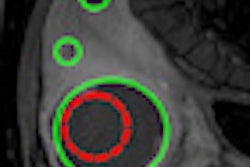
NEW YORK (Reuters Health) - Brachytherapy is a viable option for prostate cancer patients 60 and younger, the authors of a new report in BJU International conclude.
"Prostate cancer brachytherapy delivers excellent results in patients with early stage prostate cancer irrespective of their age," Dr. Karel A. Hinnen of the University Medical Center Utrecht in the Netherlands, the study's first author, told Reuters Health via e-mail.
Compared to prostatectomy and external-beam radiotherapy, he added, "brachytherapy has the lowest risk of impotency and incontinence and best (quality of life). Patients may experience bowel and urinary bother after implantation, however recent studies showed that in the majority of patients, these complaints have disappeared within the year."
Brachytherapy, and radiation treatment in general, typically are not offered to younger patients with organ-confined disease, who usually have surgery instead, Dr. Hinnen and his colleagues note in a November 9 online publication in BJU International. This is due to the lack of data on long-term outcomes with brachytherapy, they add, as well as the fact that in the days before prostate-specific antigen (PSA) screening became widespread, younger patients were usually diagnosed with advanced disease.
To better understand whether brachytherapy would be suitable for younger patients with localized disease, the researchers looked at 491 patients treated between 1989 and 2001, with follow-up ranging from seven to 18 years. All patients had intermediate or well-defined tumors, with Gleason scores of 7 or less.
All received I-125 implantation brachytherapy as monotherapy. Twenty-one percent were 60 or younger. These patients had smaller prostates and a lower prostate cancer risk class, on average, than the older patients. Follow-up averaged 9.1 years for the younger group and 8.3 years for the older patients.
The researchers used 10-year freedom from biochemical failure (PSA +2 ng/mL), disease specific survival, and overall survival as their primary outcomes. There were no statistically significant differences between older and younger patients, with 63% of younger patients and 46% of older patients free of biochemical failure 10 years after treatment. Disease-specific survival rates were 87% for the younger patients and 83% for older patients, while overall survival rates were 81% and 60%, respectively.
While there was a trend toward better outcomes for the younger patients, log-rank tests found no significant differences between the two age groups in biochemical failure risk or disease survival. Significant differences in overall survival were related to other causes of death in the older patients.
Dr. Hinnen and his colleagues say, "The reported 10-year disease-specific survival rate may well underestimate outcome after brachytherapy for contemporary treated patients."
In an interview, the researcher added: "Although young patients may be offered deferred treatment or 'active surveillance,' in many cases at some point definitive prostate cancer treatment will be necessary. The specific advantages of prostate brachytherapy are among others: the outpatient procedure and the small irradiated healthy tissue volume compared to external radiation ... the low invasiveness of the procedure, the absence of perioperative mortality and lack of hospitalization compared to surgery."
The risk of radiation-induced new cancers has, so far, proven to be smaller for brachytherapy than for external radiotherapy, Dr. Hinnen added, "with practically no increase compared to population expected rates or compared to nonirradiated patients. Although some uncertainty remains for 15+ years after treatment, the risk is in all likelihood very small and has to be set against benefits such as the lower incontinence and impotence rates during all these years."
"If doctors educate their patients in a complete and thorough manner, patients should decide which treatment they favor the most," he concluded.
By Anne Harding
Source: http://link.reuters.com/gyg49q
BJU Int 2010.
Last Updated: 2010-12-09 10:16:24 -0400 (Reuters Health)
Related Reading
Positive results reported with stereotactic RT for prostate cancer, November 23, 2010
MedCAC bombarded with info about prostate radiotherapy, April 26, 2010
Tumor tracking for prostate IMRT reduces GI side effects, March 26, 2010
CyberKnife benefits prostate cancer patients, October 1, 2009
SBRT for early prostate cancer shows promising interim results, April 9, 2009
Copyright © 2010 Reuters Limited. All rights reserved. Republication or redistribution of Reuters content, including by framing or similar means, is expressly prohibited without the prior written consent of Reuters. Reuters shall not be liable for any errors or delays in the content, or for any actions taken in reliance thereon. Reuters and the Reuters sphere logo are registered trademarks and trademarks of the Reuters group of companies around the world.


















